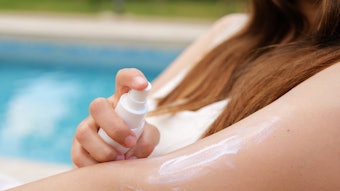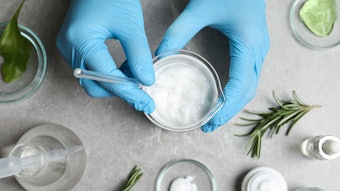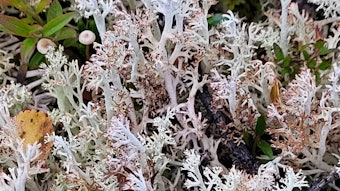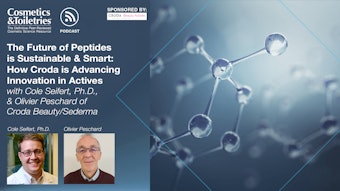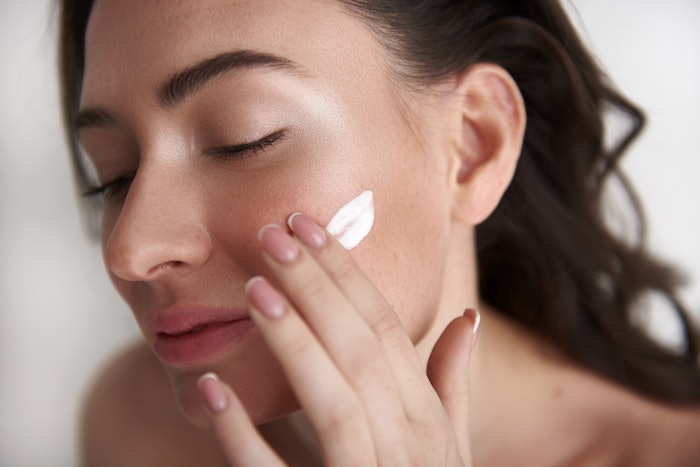
A silk peptide upcycled via biotech was developed to support the skin barrier by enhancing claudin-1 in tight junctions. Clinical studies demonstrate benefits for skin hydration, signs of aging, eczema and more from both leave-on and rinse-off formulas.
This article is only available to registered users.
Log In to View the Full Article
A silk peptide upcycled via biotech was developed to support the skin barrier by enhancing claudin-1 in tight junctions. Clinical studies demonstrate benefits for skin hydration, signs of aging, eczema and more from both leave-on and rinse-off formulas.
Traditional skin barrier products have long relied on passive occlusives or hydrophobic film-forming additives (e.g., petrolatum and silicones) and barrier lipid replenishment actives (e.g. ceramides).1-4 While these compounds reduce moisture loss by forming a superficial barrier, they may not repair the underlying causes of barrier dysfunction. In some cases, traditional barrier products, such as occlusive molecules like petrolatum, mineral oil and silicone, can even create dependency in the skin, inhibit normal skin function1 and pose environmental burdens – e.g., many are fossil fuel-based, difficult to biodegrade, energy-intensive to produce, require solvents, etc.
To shift skin barrier support from symptom-masking to a bioactive solution, a novel biomimetic peptide was upcycled via a biotechnology process from natural silk fibroin proteina. The peptide is designed to support skin homeostasis by regulating claudin-1, a key protein in the tight junctions of skin. This mechanism can improve compromised skin affected by conditions ranging from everyday dryness to eczema.5-10
The present article explores the silk protein’s mechanism of action and clinical efficacy in three studies. It also considers how it may contribute to new strategies for improving skin barrier integrity and supporting skin health.
Background: Tight Junctions, Solubility and Skin Penetration
Since the silk protein targets tight junctions, a brief background about these skin structures would be useful. Tight junctions are protein complexes that the skin relies on to regulate permeability and prevent water loss (see Figure 1a schematic). Among them, claudin-1 plays a critical role. The disruption of claudin-1 expression is associated with elevated transepidermal water loss (TEWL) and inflammatory dermatoses such as eczema, psoriasis and atopic dermatitis.11, 12 The active support of tight junctions is comparatively less-explored than stratum corneum lipid replacement.
Lipid replacement products typically rely on hydrophobic ingredients, which can limit their formulation potential, particularly in rinse-off or water-based products. In contrast, the silk peptide is water-soluble. In addition, it can go where ceramides and petrolatum cannot. More specifically, lipid-based ceramides and petrolatum work within the skin's oily intercellular lipid matrix, whereas the small water-soluble peptide can travel beyond this layer to influence deeper cellular functions – e.g., supporting the natural production of claudin-1 to proactively improve skin.
Ex vivo Activity on Claudin-1
As stated, claudin-1 is a hallmark tight junction protein in the skin barrier whose loss results in increased TEWL. To determine the ability of the silk protein to act on this protein, an ex vivo experiment was conducted in human skin biopsies from donors 30-52 years old. The biopsies were insulted by pretreatment with acetone then rinsed, following which the silk peptide was applied (or not, control) at 2% and samples were incubated for 24 hr.
Skin explants were then rinsed with DPBS solution, fixed with 4% paraformaldehyde and processed for cryostat sectioning and immunohistochemistry. Assessments were made using a digital imaging systemb. As shown by the orange staining in Figure 2, the silk peptide significantly increased the natural production of claudin-1, compared with the untreated skin.
Clinical Study 1: 4% Test Serum
The clinical implications of the silk peptide’s ability to increase claudin-1 and, in turn, effectively restore skin barrier functioning were assessed in a single arm study (i.e., without a separate control group) using a basic serum formula containing water, thickener, preservative and 4% silk peptide. The study spanned 28 days and involved the regular twice-daily application of the serum to the face, after which skin hydrationc and TEWLd were measured.
In addition, expert graders made visual assessments of skin parameters including hydration, rhytids (fine lines), firmness, smoothness, desquamation, erythema and radiance; desquamation was also assessed using adhesive taped.
Results: Results showed the silk peptide improved several skin characteristics, including signs of aging and erythema. At the conclusion of the 28-day study, on average, skin hydration increased by > 22% (p < 0.05; see Figure 1b) over the baseline, and visually, rhytids improved by > 35% (p < 0.0001; see Figure 1c). TEWL also significantly decreased (p < 0.0001) over the baseline, with an average reduction of more than 25% in the first week of the study (see Figure 1c). Improvements were additionally observed in radiance, firmness, smoothness, erythema and desquamation. These benefits showed that the silk peptide could enhance skin barrier function.
Clinical Study 2: 2% Face Serum
A second clinical study evaluated the efficacy of the silk peptide at 2% in a serum versus a placebo for improving visible signs of aging and barrier function in 50 healthy subjects (females, aged 21 to 65 years, > 20% non-Caucasian). The 28-day study was of a single-blind, home-use design. Thirty-four subjects were issued the test active serum while 23 were issued the placebo. Participants in both groups were instructed to apply a pea-sized drop of serum to the face twice daily, morning and evening. Assessments included: TEWL measurementsc; visual expert grading of erythema, rhytids and skin firmness; and a self-perception questionnaire.
Results: Fine lines and irregular pigmentation are visible signs of skin aging, and while they are multi-factorial, they can also be associated with a compromised skin barrier. At both the 7- and 28-day time points, twice daily application of the serum containing silk peptide significantly reduced erythema and rhytids (see Figures 3a and c).
Visual improvements in skin firmness were also observed. And self-perception questionnaire results were favorable: > 90% of subjects agreed that skin treated with the silk peptide serum improved in terms of hydration, roughness/dryness, texture and overall appearance (not shown).
Improvements in hydration and dryness were confirmed by TEWL measurements (see Figure 3b), which were significantly improved after the silk peptide serum application, compared with placebo users. Indeed, silk peptide serum users averaged a 17.0% and 18.7% reduction (improvement) in TEWL from baseline after 7 and 28 days, respectively. These results demonstrated the silk peptide could significantly improve signs of aging and hydration in skin, versus the placebo.
Clinical Study 3: 0.5% Body Wash on Eczema-prone Skin
A third clinical was carried out to assess whether the silk peptide remained effective when formulated into a rinse-off product used to wash compromised skin. The seven-day, at-home use study was conducted in 30 participants (mixed gender, age 18+), each presenting with at least one eczema-prone skin site. More than 50% of the participants self-identified as having sensitive skin.
Following a seven-day washout period, participants used a body wash containing 0.5% silk peptide once daily. Application was by hand or soft washcloth. Skin assessments were made at baseline, after initial use and after seven days of use. Measurements included: clinical grading of eczema using the Investigator Global Assessment (IGA) scale; skin hydrationb, TEWLc and redness and lesion count, as assessed by expert graders.
Results: Daily use of the silk peptide body wash significantly reduced the appearance of eczema-prone skin by 26.94% (p < 0.01), with 86.67% of subjects showing improvement following seven days of use. Skin redness was also significantly reduced by 40.2% over the seven-day period, with 93.33% of subjects showing improvements. The average number of eczema-prone skin sites was reduced significantly as well, by 25.68% (p < 0.01, see Figure 4), with 70% of subjects seeing improvements in skin.
What’s more, the silk peptide body wash significantly improved skin hydration and barrier function (p < 0.01, see Figure 4). Skin hydration showed an immediate improvement of 6.97%, which after seven days of use, increased to 23.60%. TEWL decreased by an average of 5.88% immediately after first use; following seven days of use, this improved to an 11.82% reduction. These results showed the silk peptide body wash formulation significantly improved skin hydration after just one use, and reduced the appearance of eczema-prone skin sites in a seven-day human study.
Discussion and Conclusion
The skin barrier is more than a shield. It’s a living, dynamic interface that requires bioactive support. The silk peptide discussed here increased claudin-1 expression in support of tight junction integrity and, in turn, enhanced hydration.
The efficacy shown in both leave-on and rinse-off applications offers a new way to think about how the barrier function can be addressed – by working with the skin’s biology to restore tight junction integrity and improve skin health. Formulators can take this approach using the described silk peptide to enhance product performance without compromising sustainability or consumer safety.
Footnotes
a Silk Peptide 33B (INCI: Soluble Fibroin) is a product of Evolved By Nature
b EVOS M7000 microscope by Thermo Fisher Scientific using 2x magnification with DAPI and Tx-Red filter cubes
c Corneometer
d Tewameter
e D-Squame
References
- Zhai, H. and Maibach, H.I. (2002). Occlusion vs. skin barrier function. Skin Res Technol, 8 1–6.
- Warner, R.R., et al. (1999). Water disrupts stratum corneum lipid lamellae: Damage is similar to surfactants. J Invest Dermatol, 113 960–966.
- Warner, R.R., Stone, K.J. and Boissy, Y.L. (2003). Hydration disrupts human stratum corneum ultrastructure. J Invest Dermatol, 120 275–284.
- Sethi, A., Kaur, T., Malhotra, S.K. and Gambhir, M.L. (2016). Moisturizers: The slippery road. Indian J Dermatol, 61 279–287.
- Zihni, C., Mills, C., Matter, K. and Balda, M.S. (2016). Tight junctions: From simple barriers to multifunctional molecular gates. Nat Rev Mol Cell Biol, 17 564–580.
- Furuse, M., et al. (2--2). Claudin-based tight junctions are crucial for the mammalian epidermal barrier: A lesson from claudin-1-deficient mice. J Cell Biol, 156 1099–1111.
- Tunggal, J.A., et al. (2005). E-cadherin is essential for in vivo epidermal barrier function by regulating tight junctions. EMBO J, 24 1146–1156.
- De Benedetto, A., Kubo, A. and Beck, L.A. (2012). Skin barrier disruption: A requirement for allergen sensitization? J Invest Dermatol, 132 949–963.
- Orsmond, A., Bereza-Malcolm, L., Lynch, T., March, L. and Xue, M. (2021). Skin barrier dysregulation in psoriasis. Int J Mol Sci, 22.
- Kim, B.E. and Leung, D.Y.M. (2018). Significance of skin barrier dysfunction in atopic dermatitis. Allergy Asthma Immunol Res, 10 207–215.
- Pilkington, S.M., Bulfone-Paus, S., Griffiths, C.E.M. and Watson, R.E.B. (2021). Inflammaging and the Skin. J Invest Dermatol 141, 1087–1095 (2021).
- Beck, L.A., et al. (2022). Type 2 inflammation contributes to skin barrier dysfunction in atopic dermatitis. JID Innov 2, 100131.
